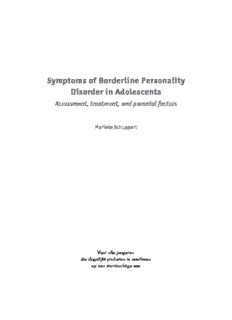
Symptoms of Borderline Personality Disorder in Adolescents PDF
Preview Symptoms of Borderline Personality Disorder in Adolescents
Symptoms of Borderline Personality Disorder in Adolescents Assessment, treatment, and parental factors Marieke Schuppert Voor alle jongeren die dagelijks proberen te overleven op een stormachtige zee Schuppert, HM Symptoms of borderline personality disorder in adolescents Assessment, treatment, and parental factors The research described in this thesis was supported by grants from the University Medical Centre Groningen and ZonMw (The Netherlands Organization for Health Research and Development). ISBN: 978-90-367-5705-8 Copyright © Marieke Schuppert, 2012 Layout: Helga de Graaf, Studio Eye Candy, Groningen (www.proefschrift.info) Image cover: Hiltje Koopmans, ‘être’, 2012 Printed by Ipskamp Drukkers RIJKSUNIVERSITEIT GRONINGEN Symptoms of Borderline Personality Disorder in Adolescents Assessment, treatment, and parental factors Proefschrift ter verkrijging van het doctoraat in de Medische Wetenschappen aan de Rijksuniversiteit Groningen op gezag van de Rector Magnificus, dr. E. Sterken, in het openbaar te verdedigen op woensdag 3 oktober 2012 om 11.00 uur door Hermine Maria Schuppert geboren op 28 januari 1969 te Holten Promotores: Prof. dr. R.B. Minderaa Prof. dr. P.M.G. Emmelkamp Copromotores: Dr. M.H. Nauta Dr. J. Bloo Beoordelingscommissie: Prof. dr. K. Silk Prof. dr. R.A. Schoevers Prof. dr. F. Boer Contents Chapter 1 Introduction 9 Chapter 2 Psychometric evaluation of the Borderline Personality 29 Disorder Severity Index IV – adolescent version and parent version Chapter 3 Effectiveness of an Emotion Regulation Group Training 43 for adolescents - a randomized controlled pilot study Chapter 4 Emotion Regulation Training for adolescents with 61 borderline personality disorder traits: a randomized controlled trial Chapter 5 Parental rearing and psychopathology in mothers of 79 adolescents with and without borderline personality symptoms Chapter 6 Severity of borderline personality symptoms in 91 adolescence: relationship with parenting stress, parental psychopathology, and rearing styles Chapter 7 General discussion 105 Chapter 8 References 123 Summary 138 Samenvatting 144 Dankwoord 152 Curriculum Vitae 156 Chapter 1 Introduction Chapter 1 Personality is a complex concept that refers to a broad range of individual dif- ferences in the way people tend to think, feel and act. Personality traits (like for instance extraversion, neuroticism and conscientiousness) can be recognized at an early age and are moderately stable (de Fruyt et al., 2006; Shiner, 2005). In a large meta-analysis, Roberts and DelVecchio (2000; Roberts, Walton, and Viechtbauer, 2006) found that trait consistency increases steadily over the years: from .31 in childhood to .54 in young adults, to .64 at age 30 and .74 be- tween 50 and 70 years. Although there is moderate personality stability already in childhood, there is also considerable personality change (Specht, Egloff, and Schmukle, 2011). In general, trait profiles are not pathological. Both adaptive and maladaptive personality patterns can be described in domains of functioning, like impulsivity, emotional lability/instability, or interpersonal functioning (Livesley, 2012). Extreme traits can be associated with an increased risk for personality pathology and related disorders. Though the symptoms in children are not neces- sarily the same as in adults, childhood antecedents of personality disorders can be well determined (Mervielde et al., 2005; Paris, 2003). For many years, both clinicians and researchers have been reluctant in diagnos- ing personality disorders (PD) before age 18. One of the arguments was that personality is still developing during adolescence, and that symptoms are not stable enough to fit a valid and reliable diagnosis. In clinical practice, mental health professionals are still hesitating in diagnosing PDs in young people. DSM- IV-TR (APA, 2000) discourages the diagnosis of PDs in youngsters. One of the consequences of this reluctance is that relatively little research has been done on (symptoms of) PDs in adolescence, and, more specifically, on borderline person- ality disorder (BPD) (Crick, Murray-Close, and Woods, 2005; Paris, 2003). Yet, DSM-IV provides the opportunity to diagnose (B)PD when there is a pervasive, persistent pattern of maladaptive personality traits, that must have been present for at least one year, and is not likely to be limited to a particular developmen- tal stage or Axis I disorder (APA, 2000). Another consequence of the restraints about diagnosing (B)PD at an early age, is that very little age-specific treatments have been developed and evaluated (Chanen, Jovev, McCutcheon, Jackson, and McGorry, 2008b). In recent decades, the development of BPD has increasingly become a focus of interest. Several studies have now found ample evidence for a reliable and valid diagnosis in adolescence (e.g. Crawford et al., 2008; Paris, 2003; Miller, Muehlenkamp, and Jacoboson, 2008). In an epidemiological study, BPD in adolescence was found to be a predictor for psychopathology and psychosocial dysfunctioning later in life. For instance, in a 20 year follow-up study (Children 10
Description: